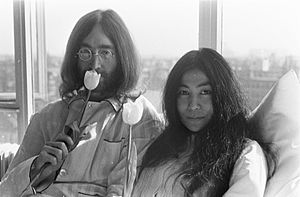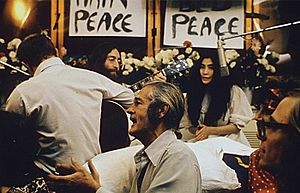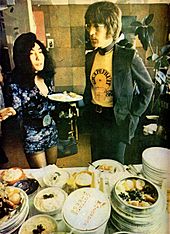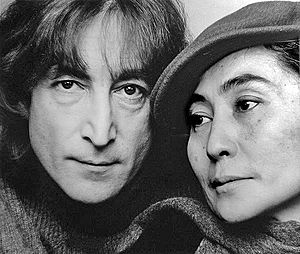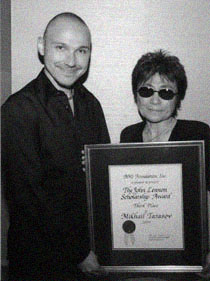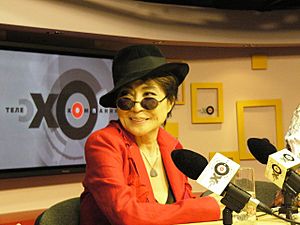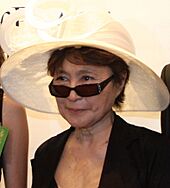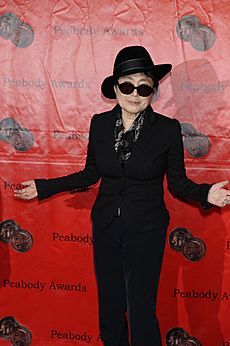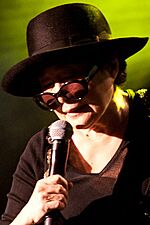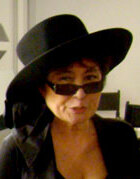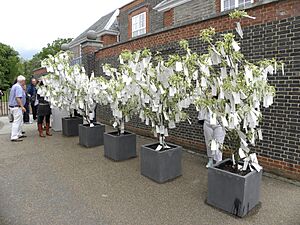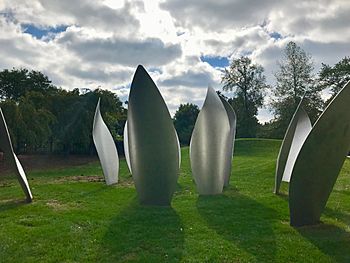Yoko Ono facts for kids
Quick facts for kids
Yoko Ono
|
|
|---|---|
| 小野 洋子 オノ・ヨーコ |
|
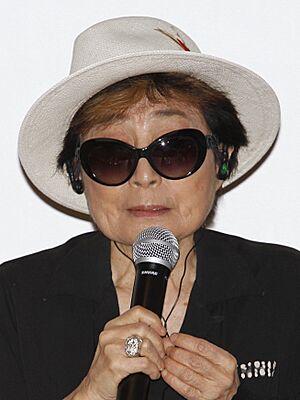
Ono in 2016
|
|
| Born | February 18, 1933 |
| Other names | Yoko Ono Lennon |
| Alma mater | Gakushuin University Sarah Lawrence College |
| Occupation |
|
| Spouse(s) |
Anthony Cox
(m. 1962; ann. 1963)
(m. 1963; div. 1969) |
| Children | 2, including Sean Ono Lennon |
| Musical career | |
| Genres |
|
| Instruments |
|
| Years active | 1961–2021 |
| Labels | |
| Signature | |
Yoko Ono (Japanese: 小野 洋子, romanized: Ono Yōko, also known as オノ・ヨーコ; born February 18, 1933) is a Japanese artist, singer, songwriter, and peace activist. She is also known for her performance art and filmmaking.
Yoko Ono grew up in Tokyo, Japan. In 1952, she moved to New York City to live with her family. She became part of the city's art scene in the early 1960s. This scene included a group called Fluxus. She became very famous in 1969 when she married English musician John Lennon from the Beatles.
Yoko and John recorded music together as the Plastic Ono Band. They used their honeymoon to protest the Vietnam War. They called their protest a bed-in. Yoko and John were married until he was sadly killed on December 8, 1980. They had a son named Sean, who also became a musician.
Yoko started her career in popular music in 1969. She formed the Plastic Ono Band with John Lennon. They made many unique, experimental albums in the 1970s. In 1980, she had great success with the album Double Fantasy. This album was a collaboration with John Lennon. It was released just three weeks before he passed away. The album won a Grammy Award for Album of the Year.
Yoko Ono has had twelve number one songs on the US Dance charts. In 2016, Billboard magazine called her the 11th most successful dance club artist ever. Many musicians see Yoko as an important artist and an inspiration.
As John Lennon's widow, Yoko works to keep his memory alive. She helped create the Strawberry Fields memorial in Manhattan's Central Park. She also funded the Imagine Peace Tower in Iceland. She has given a lot of money to support the arts, peace, and help for disasters. In 2002, she started the $50,000 LennonOno Grant for Peace, which is given every two years.
Contents
Yoko Ono's Early Life
Growing Up in Japan
Yoko Ono was born on February 18, 1933, in Tokyo City, Japan. Her parents were Isoko Ono and Eisuke Ono. Her father was a wealthy banker and a talented classical pianist. Yoko's family was very well-known. Her name Yōko (洋子) means "ocean child" in Japanese.
Just two weeks before Yoko was born, her father moved to San Francisco, California for his job. The rest of the family joined him later. Yoko first met her father when she was two years old.
In 1937, her family moved back to Japan. Yoko went to Gakushūin, a very special school in Tokyo. She took piano lessons from age 4 to 12 or 13. Her mother was also musical and enjoyed traditional Japanese instruments.
World War II and Its Impact
The family moved to New York City in 1940. But the next year, they returned to Japan. Yoko stayed in Tokyo during World War II. She experienced the terrible fire-bombing of March 9, 1945. She and her family had to hide in a special bunker.
After the bombings, there was a lot of hunger in Tokyo. Yoko's family had to beg for food. They pulled their belongings in a wheelbarrow. Yoko said this time made her "aggressive" and helped her understand what it felt like to be an "outsider." Her mother sometimes traded valuable items for food. For example, she traded a German sewing machine for rice to feed the family.
After the war ended in 1945, Yoko stayed in Japan. Her family moved to the United States. In April 1946, her school, Gakushūin, reopened. It was not damaged by the war. Yoko became a classmate of Prince Akihito, who would later become the emperor of Japan.
Becoming an Artist
College and Early Art Scene
Yoko Ono finished Gakushūin in 1951. She was the first woman to join the philosophy program at Gakushuin University. But she left after two semesters.
In September 1952, Yoko joined her family in New York. She went to Sarah Lawrence College. Her parents liked her choice of college. However, they did not like her lifestyle or the friends she made. In 1956, Yoko left college to marry Japanese composer Toshi Ichiyanagi. He was a rising star in experimental music.
At college, Yoko studied poetry, English literature, and music. She was very interested in composers like Arnold Schoenberg. Her teacher told her that her music was "avant-garde," which means very new and experimental. She was introduced to the music of John Cage.
In 1957, Yoko moved to New York City. She worked as a secretary and taught traditional Japanese arts. Yoko is often linked to the Fluxus group. This group of artists in the early 1960s was inspired by Dadaism. They created very unusual and experimental art. George Maciunas, who started Fluxus, really liked Yoko's work. He gave her first solo art show in New York in 1961. She chose not to officially join Fluxus because she wanted to be independent. But she did work with many artists from the group.
Yoko met John Cage through his student, Toshi Ichiyanagi. She learned more about Cage's unique art ideas. After Cage stopped teaching in 1960, Yoko decided to rent a place to show her art. She found an inexpensive loft at 112 Chambers Street in downtown Manhattan. She used it as her studio and home. She also let composer La Monte Young organize concerts there.
They held a series of events from December 1960 to June 1961. Famous artists like Marcel Duchamp attended. Yoko showed some of her first conceptual artworks there. One piece was Painting to Be Stepped On. It was a canvas on the floor that became art when people walked on it. This showed that art didn't always need to be on a wall.
In 1961, Yoko had her first big public performance at Carnegie Recital Hall. She presented radical experimental music and performances.
After living apart for several years, Yoko and Toshi Ichiyanagi divorced in 1962. Yoko went back to live with her parents. She was going through a very difficult time and needed help. She was briefly in a Japanese hospital.
Marriage and Motherhood
On November 28, 1962, Yoko married Anthony Cox. He was an American jazz musician and art promoter. He helped her get out of the hospital. Their marriage was later cancelled because her divorce from Ichiyanagi was not final yet. After her first divorce was complete, Yoko and Anthony married again on June 6, 1963. Their daughter, Kyoko Chan Cox, was born two months later, on August 8, 1963.
Their marriage did not last, but they stayed together for their careers. They performed in Tokyo. Yoko often left Kyoko's care to Anthony while she focused on her art. Anthony also helped manage her public image.
Yoko had another show at Carnegie Recital Hall in 1965. Here, she first performed Cut Piece. In September 1966, Yoko visited London for an art event. She was one of the few women artists chosen to perform her own work. She showed The Fog Machine in Liverpool, England, in 1967.
Yoko and Anthony divorced on February 2, 1969. She married John Lennon later that year. In 1971, during a custody battle, Anthony disappeared with their eight-year-old daughter. He won custody. Yoko's ex-husband changed Kyoko's name to "Ruth Holman." Yoko and John searched for Kyoko for many years but could not find her. She finally saw Kyoko again in 1998.
Yoko Ono and John Lennon
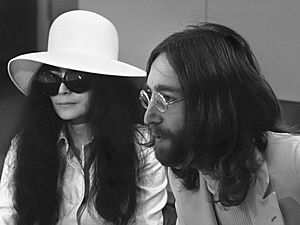
Yoko first met a member of the Beatles when she visited Paul McCartney in London. She wanted a song manuscript for a book John Cage was working on. Paul suggested that John Lennon might help her. John later gave Yoko the original handwritten lyrics to his song "The Word".
Yoko and John Lennon first met on November 7, 1966. This was at the Indica Gallery in London. Yoko was setting up her art show called Unfinished Paintings. The gallery owner introduced them. One of Yoko's art pieces, Ceiling Painting/Yes Painting, had a ladder. When John climbed the ladder, he looked through a magnifying glass and saw the word YES written very small. He loved this because it was a positive message.
John was also interested in Yoko's Hammer a Nail piece. Viewers were invited to hammer a nail into a white wooden board. Even though the show wasn't open yet, John wanted to hammer a nail. Yoko stopped him. The gallery owner said, "Don't you know who this is? He's a millionaire!" Yoko pretended not to know the Beatles. But she agreed if John paid her five shillings. John replied, "I'll give you an imaginary five shillings and hammer an imaginary nail in."
Yoko started writing to John, sending him her art ideas. Soon, they began writing to each other often. In September 1967, John helped Yoko with her solo show in London.
In early 1968, John wrote the song "Julia". It included a line about Yoko: "Ocean child calls me." This referred to the meaning of Yoko's Japanese name. In May 1968, John invited Yoko to visit him. They spent the night recording experimental music. These recordings became their first album together, Unfinished Music No. 1: Two Virgins.
John's divorce from his first wife, Cynthia, was granted. On December 12, 1968, John and Yoko appeared in a BBC documentary about The Rolling Stones.
Peace Protests and Music
During the last two years of the Beatles, John and Yoko protested the Vietnam War. They made experimental recordings together. Their first album, Unfinished Music No.1: Two Virgins, had a famous cover showing them both without clothes. They also contributed to The Beatles' "White Album". Yoko added vocals to "Birthday" and sang a lead line on "The Continuing Story of Bungalow Bill". This was the only time a woman sang lead vocals on a Beatles recording.
On March 20, 1969, John and Yoko got married in Gibraltar. They spent their honeymoon in Amsterdam. There, they held a week-long Bed-In for Peace. They planned another Bed-In in the US, but they were not allowed to enter the country. So, they held one in Montreal, Canada. There, they recorded the famous song "Give Peace a Chance". John later said he regretted not giving Yoko credit for writing the song with him.
The couple often combined their activism with performance art. For example, in "bagism", they wore bags over their bodies. This was to make fun of prejudice and stereotypes. John wrote about this time in the Beatles' song "The Ballad of John and Yoko".
John changed his middle name to Ono on April 22, 1969. He used the name John Ono Lennon after that. The couple lived in England. When Yoko was hurt in a car accident, John had a large bed brought to the recording studio. This was so she could be with him while he worked on the Beatles' last album, Abbey Road.
The Plastic Ono Band
After "The Ballad of John and Yoko," John and Yoko decided to form their own band. They wanted to release their new, more personal art. They called it the Plastic Ono Band. Yoko first thought of the name in 1967 for an art show. In 1968, John and Yoko decided to use the name for all their future projects.
Under this name, Yoko and John worked on art shows, concerts, and experimental music. They even created a multi-media machine called The Plastic Ono Band. Later, the name was used for more standard rock albums.
In July 1969, John's first solo song, "Give Peace a Chance," was released. It was the first song credited to the Plastic Ono Band. Their first album, Live Peace in Toronto 1969, was recorded live in September. This band included famous musicians like Eric Clapton. Yoko performed two of her own songs on the album.
Yoko's Solo Music
Yoko released her first solo album, Yoko Ono/Plastic Ono Band, in 1970. It was a companion to John's album, John Lennon/Plastic Ono Band. Both album covers showed them leaning on each other. Yoko's album had raw, strong vocals. They sounded like animal noises and free jazz. The album reached No. 182 on the US charts.
In 1971, Yoko released Fly, a double album. She explored psychedelic rock and more experimental sounds. She also had some radio play with the song "Mrs. Lennon". The song "Don't Worry, Kyoko (Mummy's Only Looking for Her Hand in the Snow)" was about her missing daughter.
Kyoko is also mentioned in the song "Happy Xmas (War Is Over)". Yoko whispers "Happy Christmas, Kyoko," and John whispers, "Happy Christmas, Julian." This song was originally a protest song about the Vietnam War. It has since become a Christmas classic.
In 1973, Yoko recorded a song called "Joseijoi Banzai, Parts 1 and 2" in Japan. It mixed Japanese war songs with pop rhythms. This showed a new direction in her music.
Separation and Family Life
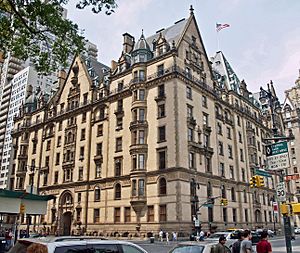
After the Beatles broke up in 1970, Yoko and John lived in London. Then they moved to Manhattan. Their relationship became difficult. They separated in July 1973. Yoko focused on her career. John lived with his personal assistant, May Pang. Yoko had given her blessing to John and May's relationship.
In December 1974, John and May thought about buying a house together. John would not take Yoko's calls. The next month, John agreed to meet Yoko. She said she had found a cure for smoking. After the meeting, John did not go home or call May. When May called, Yoko said John was tired after a hypnotherapy session. Two days later, John seemed confused. He told May that his separation from Yoko was over.
Yoko and John's son, Sean, was born on October 9, 1975. This was also John's 35th birthday. After Sean was born, both John and Yoko took a break from music. John became a stay-at-home dad to care for their baby. Sean has also become a musician, like his parents.
Return to Music and John's Death
In early 1980, John heard a song that reminded him of Yoko's music. He felt it was a sign that she was becoming more popular. Yoko and John started sharing songs over the phone. They quickly had enough material for a new album. The album was like a conversation between them. It would be credited to both John Lennon and Yoko Ono. It also marked John's return to public life after five years.
Their album, Double Fantasy, was released on November 17, 1980. It first received mixed reviews. But its legacy changed forever just weeks after its release.
On the evening of December 8, 1980, John and Yoko were at a recording studio. They were working on Yoko's song "Walking on Thin Ice". When they returned to their home, The Dakota, John was shot and killed by Mark David Chapman. Chapman had been following John for two months.
After John's death, Yoko released "Walking on Thin Ice (For John)" as a single. It became her first solo hit. Double Fantasy was then seen as a very important album of the 1980s. Yoko won a Grammy Award for Album of the Year in 1981.
In 1981, she released the album Season of Glass. The cover showed John's bloody glasses next to a glass of water. This photo sold for about $13,000 in 2002. Yoko explained that the album was not dedicated to John because "he would have been offended." The album received very good reviews.
In 1984, a tribute album called Every Man Has a Woman was released. It featured songs written by Yoko, performed by other artists. Later that year, Yoko and John's last album, Milk and Honey, was released. It included John's unfinished recordings and Yoko's new songs.
Yoko paid for the Strawberry Fields memorial in Central Park, New York. It is right across from the Dakota building, where John was killed. It was dedicated on October 9, 1985, which would have been John's 45th birthday.
Yoko's last album of the 1980s was Starpeace. This album was a message against war. On the cover, a smiling Yoko holds the Earth. The song "Hell in Paradise" was a hit. Yoko went on a world tour for Starpeace in 1986.
Later Career and Dance Hits
In 1990, Yoko worked with a music consultant to honor what would have been John Lennon's 50th birthday. Over 1,000 radio stations around the world played "Imagine" at the same time. Yoko felt it was important because of conflicts happening in the world.
Yoko took a break from music after Starpeace. In 1992, she released a six-disc box set called Onobox. It included her best solo songs and unreleased music. She also released a shorter album called Walking on Thin Ice.
In 1995, Yoko released Rising. This was a collaboration with her son Sean and his band. They went on a world tour. The next year, she worked with other alternative rock musicians for an EP called Rising Mixes.
In 1997, Yoko's solo albums were re-released on CD. Yoko and her engineer personally improved the sound. They also added extra songs. That same year, Yoko and the BMI Foundation started a music competition for songwriters. It honors John Lennon's memory.
In 2000, Yoko founded the John Lennon Museum in Japan. It had over 130 items from John and the Beatles from Yoko's private collection. The museum closed in 2010.
Yoko's album Blueprint for a Sunrise was released in 2001. A month after the 9/11 attacks, Yoko organized a concert called "Come Together: A Night for John Lennon's Words and Music." It raised money for September 11 relief efforts.
Dance Chart Success
Starting in 2003, DJs began to remix Yoko's songs for dance clubs. For this project, she used only her last name, "ONO." This was to avoid the "Oh, no!" jokes she often heard. Yoko had great success with new versions of "Walking on Thin Ice." In April 2003, her song Walking on Thin Ice (Remixes) became her first number 1 hit on Billboard's Dance/Club Play chart. She had a second number 1 hit in November 2004 with "Everyman... Everywoman...".
Yoko performed at the opening ceremony for the 2006 Winter Olympic Games in Turin, Italy. She read a poem about world peace.
Yoko released the album Yes, I'm a Witch in February 2007. It was a collection of remixes and covers of her songs by other artists. This album was well-received by critics. Another collection of her dance remixes, Open Your Box, was released in April.
On October 9, 2007, the Imagine Peace Tower was turned on in Iceland. This tower is dedicated to peace and to John Lennon. Each year, from October 9 to December 8, it shines a beam of light into the sky.
Yoko had more number 1 hits on the Dance/Club Play chart. These included "No No No" in January 2008, and "Give Peace a Chance" in August. In June 2009, at 76 years old, Yoko scored her fifth number 1 hit with "I'm Not Getting Enough".
In May 2009, she designed a T-shirt for a campaign about HIV/AIDS awareness. It had the words "Imagine Peace" in 21 languages. Yoko appeared on stage with Paul McCartney and Ringo Starr to promote Beatles: Rock Band video game.
The New Plastic Ono Band
In 2009, Yoko recorded Between My Head and the Sky. This was her first album released as "Yoko Ono/Plastic Ono Band" since 1973. The new band included Sean Lennon. On February 16, 2010, Sean organized a concert where Yoko performed with him and other musicians.
On April 1, 2010, she was named the first "Global Autism Ambassador" by the Autism Speaks organization. She had created artwork to help raise money for autism awareness.
Yoko appeared with Ringo Starr on July 7, 2010, to celebrate his 70th birthday. They performed "With a Little Help from My Friends" and "Give Peace a Chance". On October 2, Yoko and the Plastic Ono Band performed in Los Angeles. They had a special guest, Lady Gaga.
On her 78th birthday, February 18, 2011, Yoko placed a full-page ad in a UK newspaper. It was an open letter inviting people to wish for peace. With her son Sean, she held a benefit concert to help victims of the earthquake and tsunami in Japan. The concert raised $33,000. That same year, "Move on Fast" became her sixth number-one hit on the Billboard Hot Dance Club Songs chart.
In July 2011, she visited Japan to support earthquake victims. She gave a lecture and painted a large calligraphy piece called "Dream" to raise money for orphans. She also received the 8th Hiroshima Art Prize for her art and peace work.
In January 2012, a remix of her 1995 song "Talking to the Universe" became her seventh number 1 hit on the Billboard Hot Dance Club Songs chart. In March, she received the Oskar Kokoschka Prize in Austria. From June to September, her art show To the Light was shown in London.
On June 29, 2012, Yoko received a lifetime achievement award in Dublin. In February 2013, Yoko accepted the Rainer Hildebrandt Medal in Berlin. This was for her and John's work for peace and human rights. The next month, she tweeted an anti-gun message with the Season of Glass image of John's bloody glasses. She noted that guns had killed over 1 million people since John's death.
In 2013, she and the Plastic Ono Band released Take Me to the Land of Hell. It featured many guest musicians. In June 2013, she organized the Meltdown festival in London. Her online video for "Bad Dancer" was popular in November 2013. By the end of the year, she had two consecutive number 1 hits on Billboard's Hot Dance Club Play Charts.
In 2014, "Angel" was Yoko's twelfth number one on the US Dance chart. Yoko Ono/Plastic Ono Band continued to perform live into 2015.
In February 2016, an album of remixes called Yes, I'm a Witch Too was released. It received good reviews. In February 2016, Yoko was hospitalized. It was later announced that she had severe flu symptoms. In December 2016, Billboard magazine named her the 11th most successful dance club artist of all time.
In October 2018, Yoko released Warzone. It included new versions of her older songs, including "Imagine."
In November 2021, it was noted that Yoko Ono had "withdrawn from public life." Her son Sean now represents the family's interests in the Beatles' business.
Yoko Ono's Artwork
Yoko Ono is known for her unique conceptual art and performance art.
Cut Piece, 1964
Cut Piece is a very important performance artwork. It was first performed in 1964 in Kyoto, Japan. Yoko knelt on a stage, dressed in her best suit, with scissors in front of her. She invited audience members to come on stage and cut pieces of her clothing off. Yoko sat silently until she decided the piece was finished. This artwork explored ideas about gender and identity. Yoko performed it again in Paris in 2003. She said she hoped to show that "we need to trust each other."
Grapefruit Book, 1964
Yoko Ono's small book called Grapefruit is another key conceptual art piece. First published in 1964, the book is a set of instructions. The artwork is completed either by doing the instructions or by imagining them. Grapefruit has been published many times. An art critic called Grapefruit "one of the monuments of conceptual art of the early 1960s." He noted that Yoko's approach was poetic and lyrical.
Yoko performed many of the book's ideas as art pieces. These formed the basis for her art shows. One show in 1971 was almost closed because excited Beatles fans broke some art pieces. In July 2013, she released a sequel to Grapefruit called Acorn.
Experimental Films, 1964–1972
Yoko Ono was also an experimental filmmaker. She made 16 short films between 1964 and 1972. Her 1966 Fluxus film called No. 4, often known as Bottoms, is very famous. In 1996, the company Swatch made a special watch to celebrate this film.
In March 2004, the ICA London showed most of her films from this time.
Wish Tree, 1996–Present
Another example of Yoko's art that involves the audience is her Wish Tree project. A tree from the local area is placed in the art space. Her 1996 Wish Piece had these instructions:
- Make a wish
- Write it down on a piece of paper
- Fold it and tie it around a branch of a Wish Tree
- Ask your friends to do the same
- Keep wishing
- Until the branches are covered with wishes.
Her Wish Tree in the Museum of Modern Art in New York has wishes from all over the world. Other places where Wish Tree has been installed include London, San Francisco, and Japan.
In 2014, Yoko's Imagine Peace exhibit opened in Florida. Yoko put up a billboard to promote the show and peace.
When the exhibit closed, the wishes from the Wish Trees were sent to the Imagine Peace Tower in Iceland.
Earth Peace, 2014
Earth Peace was one of two artworks Yoko installed in 2014. It appeared in many places in Folkestone, England, including posters and billboards. Three parts of the artwork remain in Folkestone. One is a stone with words on it. Another is a flag that is flown every year on International Peace Day. The third is a light on a building that flashes "Earth Peace" in Morse code across the English Channel.
Skyladder, 2014
Skyladder was Yoko's second artwork in Folkestone in 2014. It is displayed in two locations. Skyladder is an artistic instruction to the people of Folkestone. The instruction says: "Audience should bring a ladder they like. Colour it. Word it. Take pictures of it. Keep adding things to it. And send it as a postcard to a friend"'.
Arising, 2015
In 2015, Yoko created the piece Arising in Venice. This artwork was part of an exhibition. When asked about the name, Yoko said that her album Rising was about people rising to fight for their rights. But she felt women were still treated unfairly. She hoped Arising would awaken "Women Power" and help men and women heal together.
Skylanding, 2016
In October 2016, Yoko unveiled her first permanent art installation in the United States. It is located in Jackson Park, Chicago. This artwork promotes peace. Yoko was inspired by a visit to the Garden of the Phoenix in 2013.
Refugee Boat, 2019
In 2019, Yoko presented her art installation Add Color (Refugee Boat). The artwork included a white room with a white rowing boat. Visitors covered both with messages and drawings. Through this artwork, Yoko showed the need for support and remembered the history of immigrants and refugees. Refugee Boat is part of Yoko's Add Color Painting series. This series invites people to add marks to white objects.
Recognition for Her Art
John Lennon once called Yoko his wife "the world's most famous unknown artist." He said, "everybody knows her name, but nobody knows what she does." Yoko has been friends with many famous artists.
In 1989, the Whitney Museum held a show of her work called Yoko Ono: Objects, Films. This marked her return to the New York art world. She decided to make some of her old pieces in bronze. She called them "petrified bronze."
In 2001, a large show of Yoko's work called Y E S YOKO ONO won a major art award. The exhibition's curator wrote that John Lennon understood Yoko's art. When he climbed a ladder to see a small word on the ceiling, he saw "YES." He felt "relieved" because it was positive. The exhibition traveled to 13 museums. In 2001, she received an honorary degree from Liverpool University. In 2009, she received a Golden Lion Award for her lifetime achievements from the Venice Biennale.
In 2012, Yoko had a major exhibition of her work in London. She also won the Oskar Kokoschka Prize, Austria's highest award for modern art. In February 2013, a large show of her work called Half-a-Wind Show opened in Germany. It traveled to other museums in Europe. In 2015, the Museum of Modern Art in New York City held a show of her early work. Also in 2015, Yoko Ono received the European Cultural Centre Art Award for her work promoting "Imagine Peace."
Discography
|
|
Books
- Grapefruit (1964)
- Summer of 1980 (1983)
- ただの私 (Tada-no Watashi – Just Me!) (1986)
- The John Lennon Family Album (1990)
- Instruction Paintings (1995)
- Grapefruit Juice (1998)
- YES YOKO ONO (2000)
- Odyssey of a Cockroach (2005)
- Imagine Yoko (2005)
- Memories of John Lennon (editor) (2005)
- 2:46: Aftershocks: Stories From the Japan Earthquake (contributor) (2011)
- 郭知茂 Vocal China Forever Love Song
- Acorn (2013)
- ”ARISING” This book is the documentation of Personal Structures Art Projects #09. Published by European Cultural Centre.
Selected Films
Movies
| Year | Title | Length | Role | Notes |
|---|---|---|---|---|
| 1965 | Cut Piece | 8:08 min | Herself | |
| 1966 | Disappearing Music for Face | 11:15 min | Subject | Fluxfilm No. 4, directed by Mieko Shimoi. Shows a close-up of Yoko's mouth. |
| 1966 | One | 5:05 min | Director | Fluxfilm No. 14; also called "Match." |
| 1966 | Eye Blink | 4:31 min | Director/Subject | Fluxfilm No. 15. |
| 1966 | Four | 9:31 min | Director | Fluxfilm No. 16. |
| 1967 | No. 4 | 80 min | Director | A longer version of Four (1966), made in London. Often called "Bottoms." |
| 1967 | Wrapping Piece | 20 min | Director/Herself | Music by Delia Derbyshire. |
| 1968 | No. 5 | 52 min | Director | Also called "Smile." Filmed on the same day as Two Virgins. |
| 1968 | Two Virgins | 19 min | Director/Herself | Filmed on the same day as No. 5. |
| 1969 | Mr. & Mrs. Lennon's Honeymoon | 61 min | Director/Herself | A documentary of the Amsterdam Bed-In for Peace. |
| 1969 | Bed Peace | 71 min | Director/Herself | |
| 1969 | Self-Portrait | 42 min | Director | |
| 1970 | Let It Be | 80 min | Herself | |
| 1970 | Up Your Legs Forever | 70 min | Director/Herself | |
| 1970 | Fly | 25 min | Director | |
| 1971 | Apotheosis | 17 min | Director/Herself | Filmed in September 1969. |
| 1971 | Erection | 20 min | Music/Supervision | Directed by John Lennon. |
| 1971 | The Museum of Modern Art Show | 7 min | Director | Audience reactions filmed by Lennon. |
| 2018 | Isle of Dogs | 101 minutes | Voice Actress ("Assistant-Scientist Yoko-ono") |
Television Shows
| Year | Title | Length | Role | Notes |
|---|---|---|---|---|
| 1969 | The David Frost Show | Herself | ||
| 1969 | The Rolling Stones Rock and Roll Circus | 66 min | Herself | Not released until 1996. |
| 1971–1972 | The Dick Cavett Show | Herself (Three episodes) | ||
| 1971 | Free Time | Herself | ||
| 1972 | Imagine | 70 min | Director/Herself/Music | A collaboration with John Lennon. |
| 1972 | The Mike Douglas Show | Herself/Host (Five episodes) | ||
| 1973 | Flipside | 22 min | Herself | Guest and musical performer with Lennon. |
| 1995 | Mad About You | 22 min | Herself (Episode: "Yoko Said") | |
| 2021 | The Beatles: Get Back | Producer/Herself | A documentary using old footage. |
Music Videos (as director)
| Year | Title | Notes |
|---|---|---|
| 1981 | "Walking on Thin Ice" | |
| 1981 | "Woman" | Music by John Lennon. |
| 1982 | "Goodbye Sadness" |
Video Art
- Sky TV (1966)
- Blueprint for the Sunrise (2000, 28 min)
- Onochord (2004, continuous loop)
Awards and Nominations
| Year | Awards | Work | Category | Result |
|---|---|---|---|---|
| 1982 | Billboard Music Awards | Herself & John Lennon | Top Billboard 200 Artist | Nominated |
| Top Billboard 200 Artist – Duo/Group | Nominated | |||
| Double Fantasy (with John Lennon) | Top Billboard 200 Album | Nominated | ||
| Juno Awards | International Album of the Year | Won | ||
| Grammy Awards | Album of the Year | Won | ||
| "(Just Like) Starting Over" | Record of the Year | Nominated | ||
| "Walking on Thin Ice" | Best Rock Vocal Performance, Female | Nominated | ||
| 1985 | Grammy Awards | Heart Play (Unfinished Dialogue) (with John Lennon) | Best Spoken Word or Non-Musical Recording | Nominated |
| 2001 | Grammy Awards | Gimme Some Truth – The Making Of John Lennon's Imagine Album | Best Long Form Music Video | Won |
| 2009 | Golden Lion Awards | Herself | Lifetime Achievement | Won |
| 2010 | Glamour Awards | Outstanding Contribution | Won | |
| 2013 | O Music Awards | Digital Genius Award | Won | |
| ASCAP Awards | ASCAP Harry Chapin Humanitarian Award | Won | ||
| 2014 | Shorty Awards | Best in Music | Nominated | |
| 2015 | Observer Ethical Awards | Lifetime Achievement Award | Won | |
| Attitude Awards | Icon Award | Won | ||
| 2016 | NME Awards | NME Inspiration Award | Won | |
| 2022 | Primetime Emmy Award | The Beatles: Get Back | Outstanding Documentary or Nonfiction Series | Won |
See Also
 In Spanish: Yoko Ono para niños
In Spanish: Yoko Ono para niños
- Feminist art movement
- List of peace activists
- An Anthology of Chance Operations
- List of music artists by net worth



